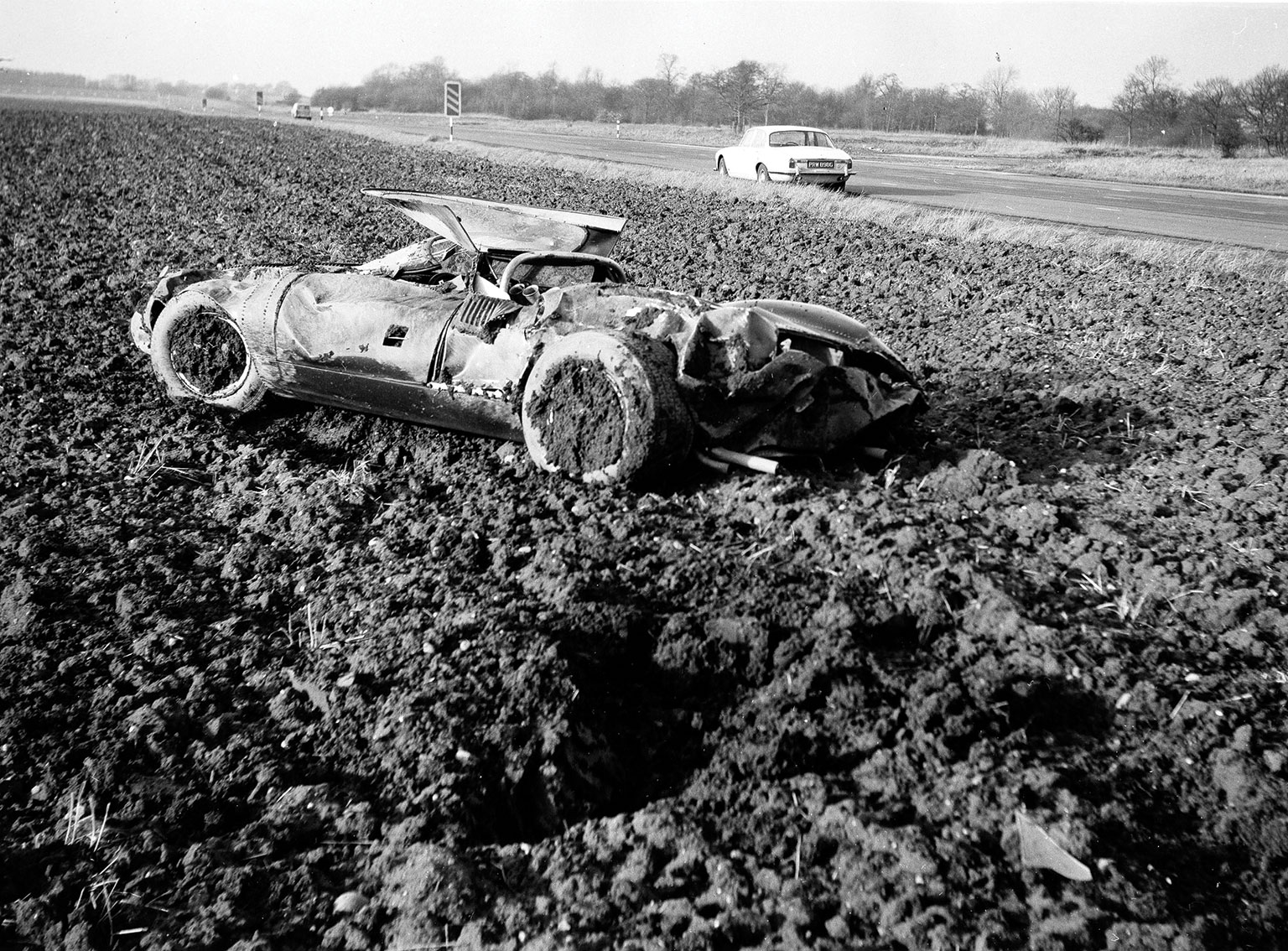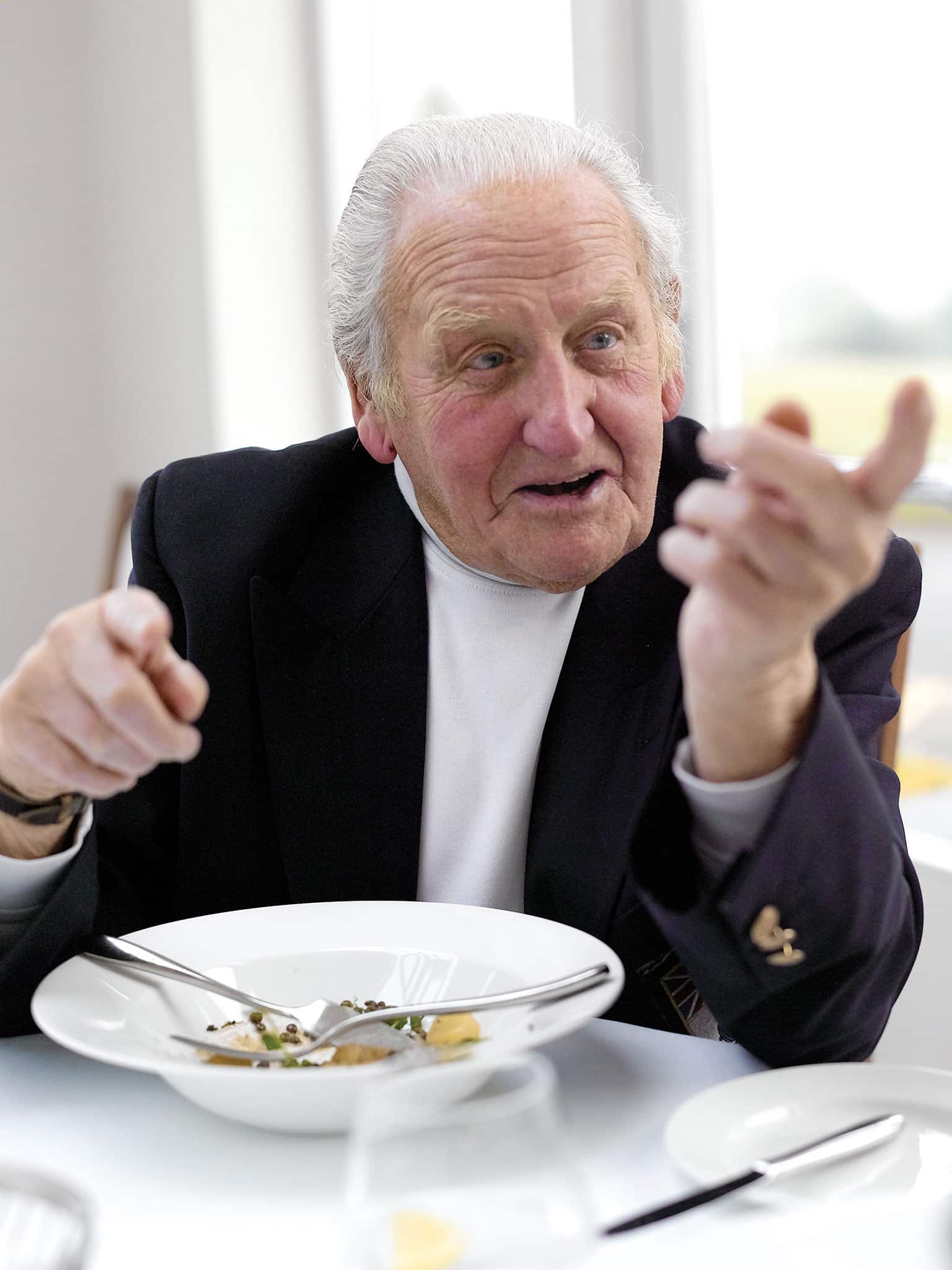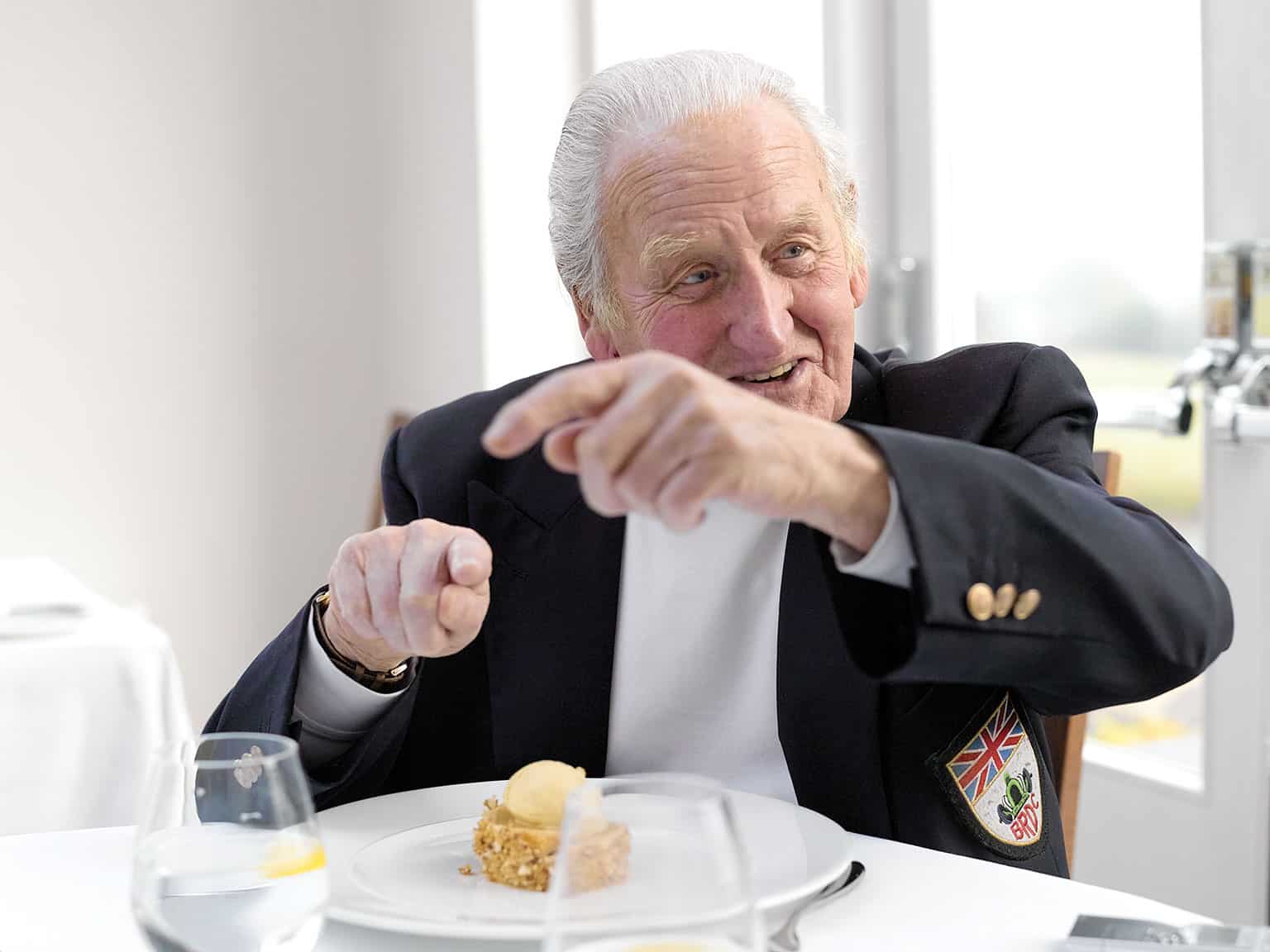Lunch with… Norman Dewis
During 33 years and more than a quarter of a million 100mph miles, this dedicated team player helped make Jaguar great

James Mitchell
Marque loyalty is an old-fashioned concept these days. A driver will swap seats after a season or two, a designer will change teams, an engineer or technician will quietly ask around to tease out available opportunities. Everyone’s looking to maximise their career potential, and more power to them. It’s the same in today’s global motor industry: a familiar face from Ford will pop up at BMW, a rising star will exchange Turin for Detroit.
But back when a few at least of the great car makers were still private businesses with paternalistic proprietors, some famous companies enjoyed a true family feeling among their key employees. This shared unity of purpose translated into the firm’s products, helping a strong identity to run through each successive model.
There’s no better example of this than Jaguar. Founded, and run with an iron hand, by Bill Lyons, it enjoyed its greatest days in the 1950s under a tight team of loyal servants: engineering boss Bill Heynes, racing manager Lofty England, vehicle engineer Bob Knight, aerodynamicist Malcolm Sayer and development test driver Norman Dewis. All of those names spent the majority of their working life with Jaguar. Norman’s own service adds up not only to 33 years but also to more than a quarter of a million miles at over 100mph, perhaps further at those speeds than any other man. The road behaviour and fitness for purpose of all the great Jaguars is very much down to the relentless work put in, often seven days a week day and night, by Norman.
Having joined Jaguar from Lea-Francis in 1952, Norman remained on the staff until the mid-80s. By then Lyons, Heynes, England, Knight and Sayer were all gone, and Jaguar was part of British Leyland. Norman now had to work through a diluted and bureaucratic reporting structure that was worlds away from the direct link he’d enjoyed to Heynes, and the frequent after-hours visits from Lyons himself to enquire how things were going.
Then, six months after he retired, his beloved wife Nan suffered a stroke. She was given two years to live, but Norman nursed her devotedly for seven. After her death he started a new life, travelling the world talking to Jaguar enthusiasts and clubs, recounting his inimitable stories about the cars he helped to develop and the people with whom he did it. He’s been doing that for 20 years and, at an extraordinarily energetic 92 years of age, he shows no sign of slowing down. Some forward planning was required to pin down this busy man for lunch at the Fishmore Hall Hotel in Ludlow, not far from his Shropshire home.

Dewis at the wheel of the Jaguar XJ test car
Norman was conveniently born in Coventry, the heart of Britain’s then thriving motor industry, in 1920. Early evidence of graphic talent resulted in a scholarship to art school; but he never took it up, for when he was only 14 his coalman father died suddenly. With the breadwinner gone he had to leave school at once and go to work, initially as a grocer’s delivery boy for 7s 6d (37.5p) a week. He lived in Humber Road, named after the big car factory along its length, and soon he was asking at the gate to see the labour manager — which is how, still only 14, he became a Humber worker, fitting wings and bonnets.
At 15 he moved to Armstrong-Siddeley, because they were able to offer him a proper five-year apprenticeship. That included a stint in the chassis department, where he learned to drive, and eventually to take the naked chassis on their shake-down runs. This progression was brought to an abrupt halt by the declaration of war in September 1939.
At once Norman, still a teenager, joined the RAF and was soon occupying the centre gun turret of a Blenheim bomber. Invalided out in 1942 he became an Air Ministry inspector, checking war production in the Midlands factories, including Lea-Francis. So when war ended in 1945 it was Lea-Francis that he joined, building engines, and then testing chassis on its quality range of post-war saloons and sports cars. They were built in small numbers, but great pride was taken in their hand finish. “We rather looked down on Jaguar, thought they were a bit mass-produced. But we couldn’t work out how they did it for the price.”
The twin-high-camshaft Lea-Francis engine was used by Connaught in their early cars, and also in American midget racing as an alternative to the ubiquitous Offenhauser. In 1948 Norman accompanied Ken Rose and Albert Ludgate of Lea-Francis to America to see the engine in action, quite an adventure for the lad from Humber Road. Meanwhile he took note of the burgeoning 500cc Formula 3 movement, and with a fellow LeaF employee designed and built a neat Rudge-powered F3 car, the DNC. In its first race, at Silverstone in July 1950, he qualified on pole and led for two laps before the cylinder barrel parted company from the crankcase and came out through the bodywork. It was rebuilt to do more races in 1951.
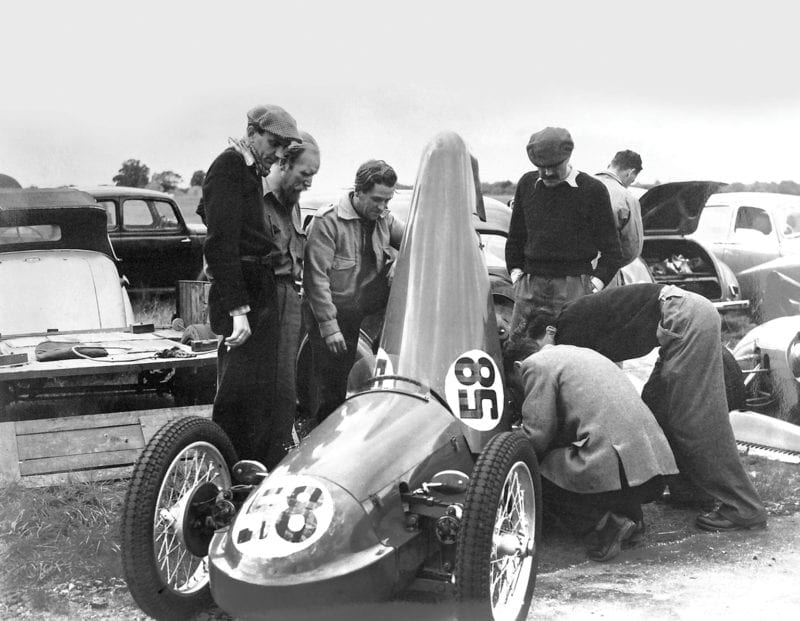
In 1950 Norman built and raced this F3 car, the DNC
Motorsport Images
As national car production got back into full swing Norman realised Lea-Francis was not in a very strong position. He put out feelers, and in October 1951 he was summoned to Bill Heynes’ office in the old Swallow Road works to discuss a job as development test driver. “I thought Jaguar seemed a tatty place, but Heynes told me about their big plans for the future, and showed me the experimental department.” There he saw not only the C-type that had won that year’s Le Mans 24 Hours, but also a mock-up of a new type of brake that, instead of an enclosed drum, had a rotating disc with external pads rubbing on it. After a haggle about money — “Jaguar had a real reputation around Coventry for being poor payers” — Norman was hired, reporting direct to Heynes who was effectively one down from Bill Lyons himself. He started on January 1, 1952.
“The Old Man liked to wander around after most people had gone home. About a week after I’d joined I was working late in the experimental department, and he came in and said, “Are you Dewis? I’m Lyons.” He called everybody by their surnames. To us he was still Mr Lyons, he didn’t become Sir William until 1956. He took me into the body shop, showed me a couple of ideas they were working on, and asked for my comments. Team spirit, you see: it started with the way the Old Man would involve you, and went on down from there.”
Norman found no properly regimented test procedures at Jaguar. His predecessor, Old Harrovian Ron “Soapy” Sutton, had moved on to Alvis to test military vehicles, and there was no consistency in any of the trials that were taking place either with the road cars or with the C-types. Norman lost no time putting in proper routines, and in this he had Heynes’ full support. “He was my boss until he left in 1969, a beautiful engineer and a great character, and always stood by me. If the production people complained that they were having to over engineer components because I was turning stuff down, refusing to sign it off, he’d always back me up. Bob Knight, too: a brilliant suspension man. Jaguar’s reputation for ride and comfort — but not at the expense of handling — started with Bob. It took us a lot of development work to get it to the levels he wanted.”
From the start Norman was heavily involved with the disc brake programme, working with Harold Hodkinson of Dunlop. The early versions were prone to alarming failures, due mainly to boiling brake fluid and pad knock-back. As well as Norman’s own testing routines at the Motor Industry Research Association (MIRA) track at Lindley, regular works drivers Tony Rolt, Duncan Hamilton, Peter Walker and Stirling Moss also tried the early C-type with disc brakes. “They were all deeply suspicious of it, although Moss was the first to recognise its potential.” As part of the test process a disc-braked C-type was entered for the 1952 Mille Miglia, with Moss as the driver, and Norman was sent along as passenger to monitor the brakes’ behaviour.
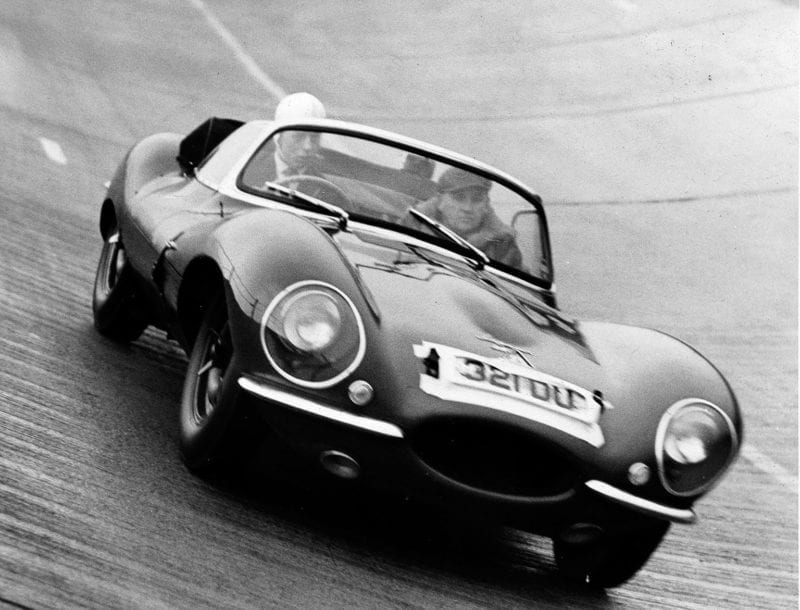
A passenger in XKSS with Prince Michael of Kent
Motorsport Images
The race began in wet conditions, and at Ravenna Moss was in 12th place. The C-type had several dust-ups with the works MercedesBenz 300SLs but by Florence, despite a leaking fuel tank and shot rear shock absorbers, they had climbed to second overall. The brakes were standing up well, but in the Abruzzi mountains a stream of water running off the hillside caught Moss out. They hit a rock and broke the steering, and with 100 miles to go their race was run. It was the start of Moss’ fascination with the Mille Miglia, which would culminate in his victory for Mercedes three years later.
Before flying home Moss sent a fateful telegram to Bill Lyons insisting that the C-types needed more straight-line speed before Le Mans if they were to beat the 300SLs. “I stayed behind to repair the Mille Miglia car before I could drive it home, and by the time I got back to Coventry the three Le Mans C-types had already been modified for more top speed, with longer noses and tails. This required changes to the cooling system, and I was dismayed to find they hadn’t been properly tested.” They were also back on drum brakes.
The 24 Hours was a disaster: after cooling problems emerged in practice, Moss’ car was converted back to the old-type radiator, but suffered engine failure, and the other two retired with overheating. “The Old Man was really livid after that. He said, ‘Nothing like this will ever happen again. In future no changes will be made without proper testing.’ So the debacle strengthened my position. From now on, everybody knew that structured testing was essential.
“Lofty England did a good job as team manager, but he was very dictatorial, and he did have the habit of being always right. He would never be corrected. He and Heynes didn’t get on at all. I had several rows with Lofty when he wanted to change something without due evaluation. If he got his way and it went wrong, he’d never admit it was down to him. It was always the driver’s fault.”
Norman was back at Le Mans in 1953, now as reserve driver across the three-car team. He therefore needed to qualify, and was sent out to do his laps on Thursday in the spare car — which, like the Tony Rolt/Duncan Hamilton C-type, was also wearing No18. So two cars numbered 18 were on-track at once, an error by England, and the organisers threatened disqualification. Lyons himself had to apologise — and C-type no18 won the race.
The famous banked triangle at MIRA, the first place on British soil for continuous highspeed testing following the demise of Brooklands, was opened in 1953, and Norman became its most frequent inhabitant. Meanwhile the Belgian motorway from Jabbeke to Aalter had become a useful venue for speed attempts, as the authorities could be persuaded to close one side of the dual carriageway, with the RAC Belgique providing independent timing.
Jaguar made headlines in 1949 when Soapy Sutton achieved 132mph in a near-standard XK120, and in 1953 they returned with an XK120 and a MkVII saloon. “In the XK I got just over 140mph, a production car record, and in the MkVII I managed 121, which was an incredible speed then in a big four-door saloon. Then one evening the Old Man came down and said to me, `Dewis, I see you’ve lost your record. What are you going to do about it?’ I hadn’t heard that the Spanish Pegaso people had gone to Jabbeke with a supercharged V8 thing, not a real production car, and they’d done 151mph.
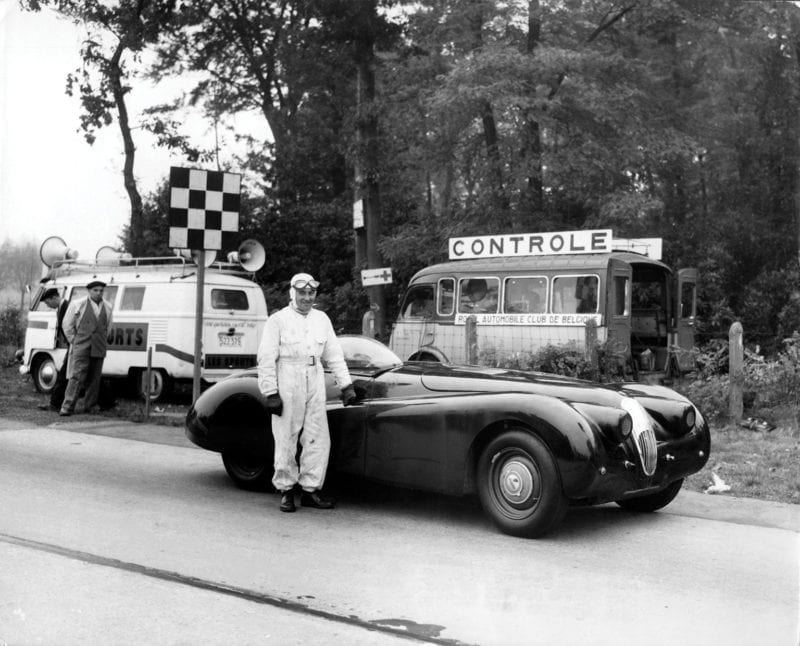
Posing with the record-breaking XK120 at Jabbeke in 1953 after beating 172mph
Motorsport Images
“I thought the XK120 had gone as fast as it was going to go, but Malcolm Sayer reckoned we might find a bit more with a full-length undertray and a plastic bubble off a glider over the cockpit. We took the seat out and I sat on the floor under the bubble, and we removed the headlights and ducted air from one side to the carbs to get a ram effect. We buffed the tread off the tyres and blew them up to 50psi, to make the contact area as small as possible. We decided to do it at dawn, when the air would be cool and dense. They’d closed five miles of one side of the dual carriageway, but even at that hour there were crowds standing along the centre reservation to watch. We were pulling our highest ratio, 2.9:1, but our engine man Jack Emerson said, ‘Don’t go over 5800rpm, you might throw a rod’.
“It’s a lovely clear morning, and when I pass the black and white boards to start the measured mile I’m pulling 6200rpm. I turn round at the other end — I can’t get out, because the cockpit cover’s screwed down; it’s very hot and airless inside — and Dunlop Mac checks the tyres and gives me the thumbs-up. I go back the other way, and I pull 6300 this time. I get to the end, they unscrew the bubble, I’m red-faced gulping in air, and nobody says anything.
“Then Lofty says, ‘You got a problem, Norman?’ No,’ I say, ‘It’s running beautifully. I was pulling 6.2, 6.3.’ Lofty says, ‘The revcounter must be playing up, you were slower than you were in April.’ He plays me along for a few moments, then he says, ‘You bugger, you’ve done 172.4. The timekeepers have confirmed it, they’re producing the certificates’.”
Sixty years ago that was an astonishing speed for a production car, and the record made headlines around the world. But the Belgian authorities decided that, with crowds lining the road, the potential for disaster was great, and no more speed attempts were allowed. Norman also drove X11, the one-off interim C-type/Dtype car, the same day but a cracked injector pipe kept its speed down to just under 180mph.
Norman’s daily work at MIRA continued, and in 1954 he was lucky to escape when a C-type being used to try fibreglass body panels seized its final drive coming off the banking at maximum speed. “It cartwheeled onto the infield, coming to rest upside down on top of me with fuel and hot oil everywhere. A couple of hefty Irish labourers were resurfacing part of the track, and they ran over and lifted the car off me. In the pub that evening I bought them all the Guinness they could drink.”
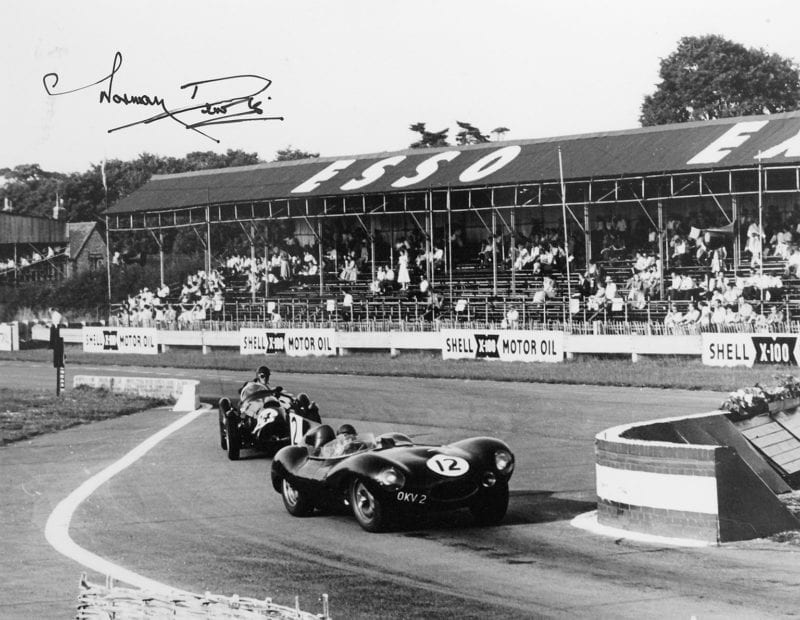
On the way to fifth place with Broadhead D-type in 1955 Goodwood nine hours
Motorsport Images
It was in 1955 that Norman had his only works Jaguar drive in a race — nothing less than the Le Mans 24 Hours. The C-type had been succeeded by the D-type, on which Norman had done a massive amount of early testing. After the D had been narrowly beaten by Ferrari at Le Mans in 1954, the much-improved long-nose car was readied for the 1955 race, and three works cars were entered for Mike Hawthorn/Jimmy Stewart, Rolt/Hamilton and Don Beauman/Desmond Titterington. Beauman, an old school friend of Hawthorn’s, was hired after a test under Lofty’s eagle eye. But, two weeks before Le Mans in the Nurburgring Eifelrennen, both Stewart and Titterington crashed their Ecurie Ecosse D-types. Titterington was laid up in hospital in Germany, and Stewart decided to retire from racing. So, days before the race, Ivor Bueb was drafted in as Hawthorn’s co driver, and Norman — who had already done more sheer miles in D-types than anyone else — found himself elevated from reserve driver to become Beauman’s partner.
The tragic story of Le Mans 1955 needs no repetition. Just before 6.30pm on Saturday, Hawthorn’s leading D-type lapped Lance Macklin’s Austin-Healey and then pulled to its right to come into the pits. Macklin, caught by surprise, swerved to his left, just as he was being lapped by Pierre Levegh’s Mercedes 300SLR. The Mercedes ran up the tail of the Healey and was launched into the packed spectator enclosure opposite the pits. Levegh and 83 spectators were killed, and 120 injured.
The accident unfolded in front of Norman, who was waiting in the pits to take over the No8 D-type from Beauman. “I believe strongly that the accident wasn’t Hawthorn’s fault. If you study the stills from the movie footage that exists, you’ll see that as Hawthorn pulls to his right approaching the pits, Macklin swerves unnecessarily far to his left to avoid him. There was actually room for Levegh to go between the Healey and the D-type — but by then Levegh was committed to passing Macklin on the left, and couldn’t avoid using the back of the Healey as a launching pad.
“We were all on the pit counter waiting for our driver changes, Bueb for Hawthorn, Hamilton for Rolt, me for Beauman. I saw Hawthorn with his hand up, coming in, I saw Macklin swerve sharply left, I saw Levegh hit him. The fire and carnage were directly across the road from us, but it didn’t affect me, to be honest. I’d seen bad things in the war, and there was a job to do. The only person it did affect was Ivor. He said, ‘It’s suicide. I’m not driving’. Lofty just said to him, `Bueb, get in the car’, and sent him out while he dealt with Hawthorn.
“Beauman handed over to me, and I did my two-hour stint. I remember winding in Kling’s 300SLR, and tailing him for three laps until finally I towed alongside on the Mulsanne just before the kink. I was pulling 6200rpm, which was 192mph on that gearing, and I went ahead. That put us fourth. I got the ‘in’ board after my two hours, but as they refuelled the car Lofty shouted, ‘Stay in! Stay in!’ so I did another hour, before handing back to Don around 10pm. We were looking good. We needed to stay out there until Sunday afternoon — and then just after midnight Don put it on top of the sandbank at Arnage. He couldn’t get it off, so gave up and walked home. It didn’t occur to him that the metal tonneau cover would have made a good shovel to dig it out.”
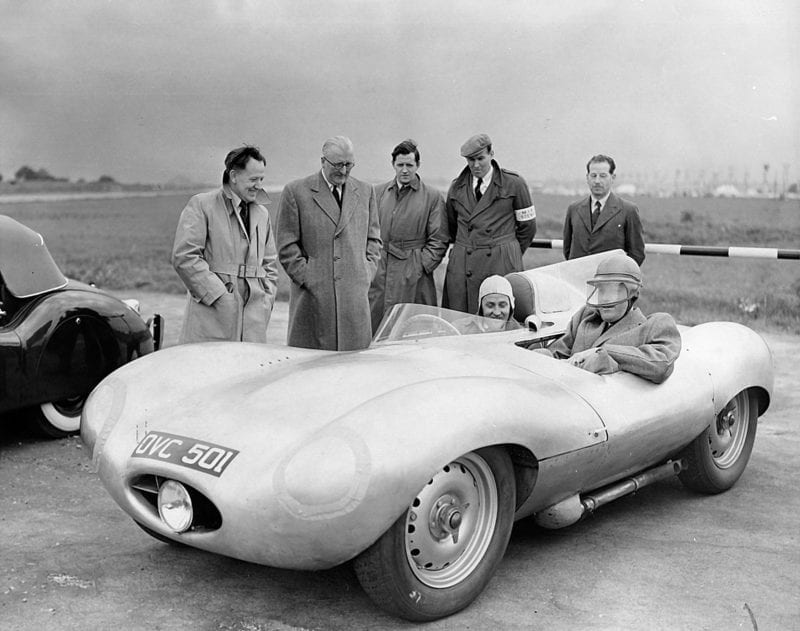
Norman in first D-type at MIRA with Minister of Transport Alan Lennox-Boyd aboard. Bill Lyons is second from left behind
Motorsport Images
In the early hours of Sunday morning, on orders from Stuttgart, Mercedes withdrew their remaining cars from the race. The D-type of Hawthorn and Bueb went on to score a hollow victory, but added to the Le Mans disaster for Jaguar was the tragic death of Bill Lyons’ only son, John. Driving down to Le Mans on the Monday before the race, his MkVII hit a truck and he was killed instantly. Having completed an apprenticeship at Leyland, he was sampling various departments around Jaguar to learn the family business, and one wonders how different Jaguar’s history might have been had he been around in the 1960s to take over the reins from his father. And four weeks later Don Beauman was dead, too, killed at the wheel of his Connaught in the Leinster Trophy race.
All the works Jaguar drivers were paid a fee per race and start money. Norman, as a waged employee, didn’t get paid for his Le Mans drive, but did think he deserved his £260 share of the start money. “Two weeks later I’d had nothing, so I told Heynes, who raised it with Teddy Huckvale, the Finance Director. He was tight, even tighter than the Old Man. He called me to his office, wrote out a cheque, and threw it down on the desk. I picked it up, and it was for £156. I told him it was meant to be £260, but he said he’d deducted £104 for hotel bills. Rolt and Hawthorn and co didn’t have to pay their hotel bills, of course, but Huckvale said I did because I was an employee. If I’d known I would have stayed in the £5 a night flophouse with the mechanics! Until you worked for Jaguar, you didn’t know what mean was.”
Norman’s other long-distance race was the 1955 Goodwood Nine Hours, when Jaguar PR manager Bob Berry asked him to share the exworks D-type he was driving for entrant Jack Broadhead. Norman had to get Bill Lyons’ permission, which was grudgingly given. Despite an off by Berry in the final hour, which required some body repairs, they finished fifth.
In May 1956 Norman earned his keep with two very hectic weekends in Europe, both involving Paul Frere. Frere wanted a mount for the big production car race at his home track, Spa, and asked Lofty England for one of the recently-introduced 2.4-litre saloons. One was readied with a C-type head, and Norman ran it up to 127mph at MIRA before driving it on the road, alone, to Spa. Up against Porsche 1600s, Mercedes 220S saloons and Jo Bonnier in a works Alfa Romeo, the 2.4 qualified well, but at the end of Saturday’s practice Frere came in to report that the gearbox had gone.
“The little lock-up Paul had found me in a village at the other end of the circuit had no pit and no ramp. The 2.4 was the first unitaryconstruction Jaguar, so the only way to get the gearbox out was from underneath. But with no means of access all I could do was take up the carpet and drill a series of holes in the floor, and then hacksaw between the holes and bend up a flap in the floor with my feet, like opening a tin, to lift the gearbox out. The bearing on the back of the layshaft had seized, and there was a tooth off second gear. The Brussels Jaguar dealer didn’t have a spare gearbox, but he sent some bits to Spa, which arrived around 7pm. So I work into the night, rebuild the box, and put it all back together. Then I try the gears, and I can’t get fourth. Take it to bits again, and find I’ve put in a shim wrong. Put it back together, and now I can’t get first. I’m tired now, and that’s what happens when you’re working on your own — although David Murray of Ecurie Ecosse heard what was going on, and lent me his chief mechanic, Stan Sproat, for a while.
“I work through the night, and next morning Paul rings to see how I’m getting on. When he hears the car’s still in bits he says, ‘Well, we can forget the race’. ‘No, no,’ I say, ‘We’ve got an hour before the race starts. Just hang on’. I’ve got no welding equipment, of course, so I kick the folded-back floor into position as best I can and put the carpet back over the holes. Then, with minutes to go, I have to get the car back up to the starting grid. The shortest route is on the circuit, going the wrong way. The Belgian marshals block me until I make them realise it’s the local hero’s car, and they wave me through. I get it to the grid, and just have time to shout to Paul to take it steady for the first two laps until he can be sure the gearbox is all right.
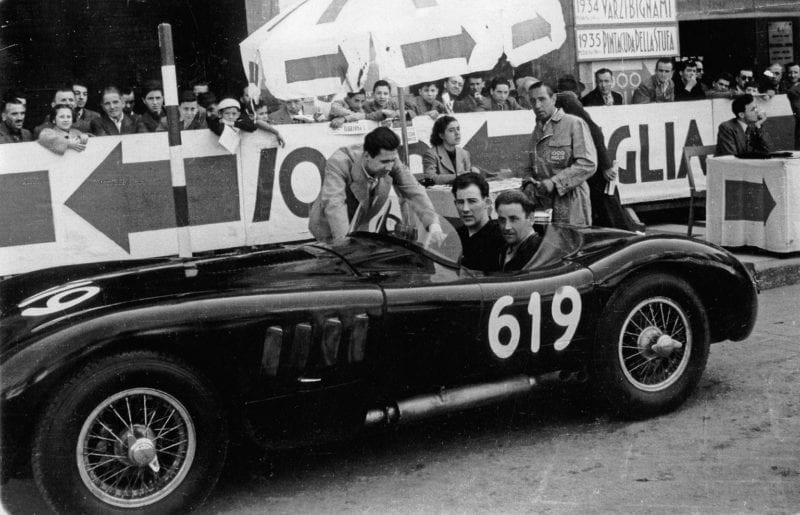
Norman accompanied a young Stirling Moss in C-type on 1952 Mille Miglia, mainly as part of disc brake development team
Motorsport Images
“As soon as Paul had gone past to complete his second lap I relaxed, and fell dead asleep. I saw nothing more of the race. Paul overtook the Mercs, led his class, got up among the Porsches, and on the last lap he passed the leading Porsche to win the race outright.” Norman shared in the Ecurie Ecosse victory dinner that evening — Ninian Sanderson’s D-type had won the main sports car race — and then on Monday morning he threw his tools into the 2.4, and drove it back to Coventry.
Eleven days later Frere was practising a works D-type for that weekend’s Nurburgring 1000Kms when he went off in the wet. “He cartwheeled down the valley, got out without a scratch, but the car was finished. This was late Friday afternoon. Lofty phoned Coventry and told Heynes I had to get another D-type over to Germany for 11am Saturday. I drove it down to Dover, caught the overnight ferry to Ostend, and at dawn I was roaring down the Jabbeke road towards Brussels. On through the Black Forest towards Dusseldorf, and then I got lost and had to ask the way. I had a map, but you can’t drive a D-type and read a map. There wasn’t too much traffic, fortunately, and the weather was clear, so I was really pressing on. I got there with 20 minutes to spare. The car was scrutineered, and Paul and Duncan Hamilton took it straight out to practise. They still had to start from the back, but they’d climbed up to sixth when the gearbox broke.”
With Jaguar’s withdrawal from racing at the end of 1956, more of Norman’s time was devoted to road car testing, although he was still responsible for development work on customer race cars for teams like Ecurie Ecosse and Briggs Cunningham. He continued to spend much of his working life at MIRA, and remembers taking the Duke of Edinburgh around the banking in an XKSS.
“All his security people said I wasn’t to do more than 80mph, but once we were out there he pointed to the top of the banking and shouted, ‘Take me up there’. At about 135mph he wanted to know what revs we were doing. Then going down the back straight he motioned me to stop. I thought maybe he was feeling a bit queasy. But he said, ‘Will you let me drive?’ So I let him take over, and when we passed the security chaps they were waving frantically. When we stopped they started to be really angry with me, but Philip silenced them at once, saying it had been at his request. Then he said to me with a grin, `Do you think I make a good driver?’ I said to him, ‘I think you’re Orroight’.
“Then I was asked to assess Prince Michael of Kent because he wanted to get a sports car. We had a private session at MIRA on a Saturday morning, and he drove an XKSS while I gave him a few pointers. A few days after that I’m in the office late one evening, and the Old Man comes down waving a newspaper. `Dewis, you didn’t do a very good job with Prince Michael. It says here he’s just ordered a new Aston Martin…”
Norman has stories about developing every type of Jaguar, not least the remarkable E-type. The earliest prototype, E1A, first ran in May 1957; E2A was raced in Cunningham colours in 1960. In the run-up to the E-type’s launch in March 1961 Norman put in days and weeks of sorting at MIRA and elsewhere to ensure that the agreed goal of 150mph was attainable. In the first published road tests both coupe and convertible duly achieved that figure — a sensational speed more than half a century ago for a series production car costing barely £2000. For Norman the E-type was “an icon”.
But ask him which Jaguars he remembers most fondly, and he’ll list the XK150S — “a beautiful car” — and, of course, the long-nose D-type. And he reserves a special place in his heart for “my XJ13. I know she caught me out, but she’s still a lovely thing”.
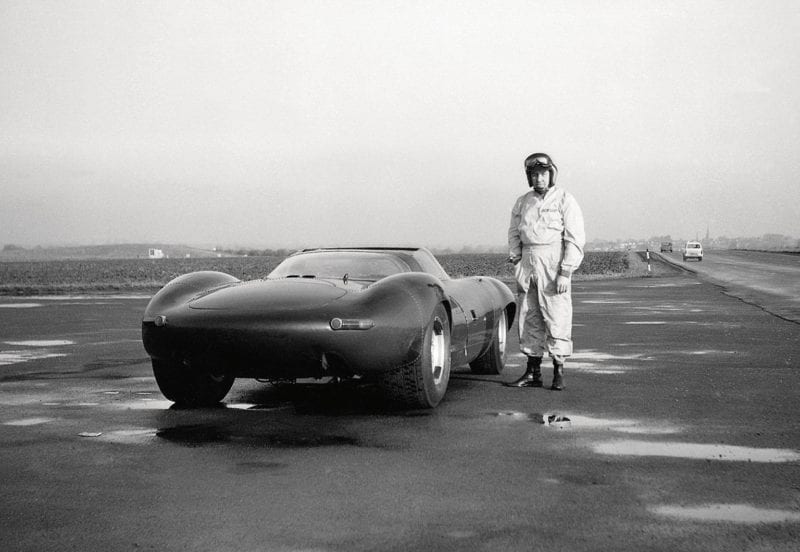
Norman about to climb aboard the unique XJ13 and, below, how that run ended after a wheel broke on MIRA banking
Motorsport Images
That unique XJ13, the first mid-engined Jaguar, was completed in 1966, using a fourcam five-litre V12. “It was intended for Le Mans originally, but the merger with BMC was going through, and when it was finished the Old Man sent around a memo saying it wasn’t to be driven. I really wanted to know what it was like, of course, so a few weeks later I said to George Mason, who’d built it, ‘Don’t tell anyone, but put the XJ13 on a trailer on Sunday 1 and take it to MIRA. I’ll see you there at 7am’.
“Well, it was all unsorted, the handling was bloody awful and it wouldn’t steer straight. But I did four laps of the outer circuit at an average of 157mph, faster than I’d ever gone with a D-type. First thing Monday morning I get a message: Sir William wants to see you at once. I go into his office, he’s standing with his back to me looking out of the window, hands clasped behind his back. ‘Where were you yesterday, Dewis?’ I was at MIRA, Sir William.”Yes, you were at MIRA with the XJ13. I circulated a memo specifically saying it was not to be run’. ‘Oh,’ I said, ‘that was three weeks ago. I thought it was just a temporary ban’. He turned around from the window, his face very red, and said, ‘Oh, you did, did you? Next time I send you a memo, Dewis, do as I say. Now then, how did it go?’ He was longing to know.
“I told him it was quick, but needed a lot of work, and I asked him if we could carry on. Eventually he said, ‘I suppose you could test it on Sundays, when things are quiet, and in your own time’. So over the months that followed we gradually developed the XJ13 at MIRA, and at Bruntingthorpe we did more than 200mph in straight-line tests. Then in 1968 came the amalgamation with Leyland. Their boss Lord Stokes operated a formal no-racing policy, and the XJ13 was put away.”
But in 1971, when the V12 E-type was being launched, it was dusted off to make a publicity film. It got a complete check-over, and the wheels it had worn for most of its testing life were replaced with new ones from the stores.
“I was high on the banking at about 135mph when the offside rear wheel broke. It spun down the banking onto the infield, dug in, did two cartwheels and then a series of barrel-rolls. I wasn’t strapped in, but while it was all going on I managed to wedge myself under the scuttle. The wreck ended up on its wheels, and I got myself out.” Miraculously he had severe bruising but no broken bones. “I had a hospital check-up and went home. I told Nan I’d had a busy day, and wanted an early night. I was so stiff next day I had to force myself to get up and go to work. Unfortunately one of the MIRA people leaked the story to the Coventry Evening Telegraph, and Nan read ‘Mr Norman Dewis crashes experimental vehicle at 140mph’. So no secrets from her.” It was two more years before the badly damaged monocoque was rebuilt, and the XJ13 ultimately became part of the Jaguar Daimler Heritage Trust.
“After the Leyland takeover I found myself working for this big loose organisation, where they’d have two men to do one man’s job. The Old Man retired as managing director in 1967, although he carried on as chairman for a bit, and Heynes retired in 1969. Malcolm Sayer died of a heart attack in 1970. Lofty England was managing director for a while, and so was Bob Knight — until 1980, when he had to deal with John Egan as chairman. They disagreed about engineering policy, and one morning Bob packed up his things, left his car keys and office keys with me, got on the bus and went home.
“I crossed swords with Egan when he called a big management meeting — he was a very good showman on stage — and said, ‘Right gentlemen, on suchand-such a date we’re going to launch the new XJ40’. I stood up and said, ‘Where did you get this launch date from? There are 14 more test procedures I haven’t signed off yet’. Egan summoned me and Director of Engineering Jim Randle to his office, and I said to Jim, ‘I’ll carry on with the programme, but in three months I’m retiring, so you’ll have to sort it out’. Well, they launched the XJ40 on that date, and it was the worst Jaguar that ever left the factory. Eventually they got it right and it was a beautiful car, but by that time the warranty costs were horrendous and two dealers in America had gone bust.’
Since Norman’s retirement from Jaguar in 1985, and then following Nan’s sad illness and death in 1993, his life has been incredibly busy. A natural story-teller, he has held audiences spellbound without notes around Europe, in America, in Australia and New Zealand. He has helped revive the British Racing Mechanics’ Club, and has taken part in a huge variety of Jaguar events, including D-type cavalcades to Le Mans, being reunited with the ex-works short-nose D-type OKV 2 at Monterey, and marking 60 years of that C-type Mille Miglia debut with Stirling Moss. He even clocked up no fewer than 82 high-speed laps of Goodwood in Nigel Webb’s long-nose D-type, giving journalists demo rides — aged 84.
The work this man has done, and is still doing, to enhance the magic of the Jaguar name is immeasurable. All this from somebody who left school at 14, and has always been driven by a belief in hard work, and that old-fashioned concept of marque loyalty.
